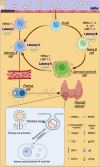The Potential Role of Virus Infection in the Progression of Thyroid Cancer
- PMID: 38751704
- PMCID: PMC11092407
- DOI: 10.14740/wjon1830
The Potential Role of Virus Infection in the Progression of Thyroid Cancer
Abstract
Multiple factors have engaged in the progression of thyroid cancer (TC). Recent studies have shown that viral infection can be a critical factor in the pathogenesis of TC. Viruses, such as Epstein-Barr virus (EBV), hepatitis C virus (HCV), human immunodeficiency virus (HIV), and severe acute respiratory syndrome coronavirus 2 (SARS-CoV-2), may play an essential role in the occurrence, development, and even prognosis in TC. This review mainly explored the potential role of viral infection in the progress of TC. The possible mechanisms could be recognizing the host cell, binding to the receptors, affecting oncogenes levels, releasing viral products to shape a beneficial environment, interacting with immune cells to induce immune evasion, and altering the pituitary-thyroid axis. Thus, comprehensive knowledge may provide insights into finding molecular targets for diagnosing and treating virus-related TC.
Keywords: Epstein-Barr virus infections; HIV; Hepacivirus; SARS-CoV-2; Therapeutics; Thyroid cancer; Virus diseases.
Copyright 2024, Wu et al.
Conflict of interest statement
The authors declare that they have no known conflict of interest or personal relationships that could have appeared to influence the work reported in this paper.
Figures



Similar articles
-
Deciphering the Relationship between SARS-CoV-2 and Cancer.Int J Mol Sci. 2023 Apr 25;24(9):7803. doi: 10.3390/ijms24097803. Int J Mol Sci. 2023. PMID: 37175509 Free PMC article. Review.
-
Multiple Viral microRNAs Regulate Interferon Release and Signaling Early during Infection with Epstein-Barr Virus.mBio. 2021 Mar 30;12(2):e03440-20. doi: 10.1128/mBio.03440-20. mBio. 2021. PMID: 33785626 Free PMC article.
-
Hepatitis C virus-Epstein-Barr virus interaction in patients with AIDS.J Med Virol. 2002 Aug;67(4):510-5. doi: 10.1002/jmv.10130. J Med Virol. 2002. PMID: 12115996
-
Implications of viral infections and oncogenesis in uterine cervical carcinoma etiology and pathogenesis.Front Microbiol. 2023 May 24;14:1194431. doi: 10.3389/fmicb.2023.1194431. eCollection 2023. Front Microbiol. 2023. PMID: 37293236 Free PMC article. Review.
-
Seroprevalence of Epstein-Barr virus, hepatitis B virus, hepatitis C virus, and human immunodeficiency virus among patients with non-Hodgkin's lymphoma at the Yaounde General Hospital, Cameroon.Pan Afr Med J. 2022 May 19;42:58. doi: 10.11604/pamj.2022.42.58.31473. eCollection 2022. Pan Afr Med J. 2022. PMID: 35949454 Free PMC article.
Cited by
-
Xenotropic and polytropic retrovirus receptor 1 (XPR1) promotes progression of papillary thyroid carcinoma via the BRAF-ERK1/2-P53 signaling pathway.J Endocrinol Invest. 2025 Mar;48(3):633-652. doi: 10.1007/s40618-024-02481-5. Epub 2024 Nov 2. J Endocrinol Invest. 2025. PMID: 39487939
-
Narrative overview of possible preventive measures for differentiated thyroid carcinomas.Heliyon. 2024 Dec 18;11(1):e41284. doi: 10.1016/j.heliyon.2024.e41284. eCollection 2025 Jan 15. Heliyon. 2024. PMID: 39811343 Free PMC article. Review.
-
Exploring the mechanism of vitamin C on the co-expressed genes of papillary thyroid carcinoma and Epstein-Barr virus based on bioinformatics, network pharmacology and molecular docking analysis.Discov Oncol. 2025 Mar 15;16(1):325. doi: 10.1007/s12672-025-02034-z. Discov Oncol. 2025. PMID: 40088359 Free PMC article.
References
Publication types
LinkOut - more resources
Full Text Sources
Miscellaneous
